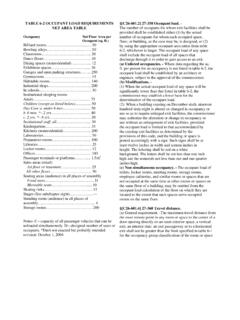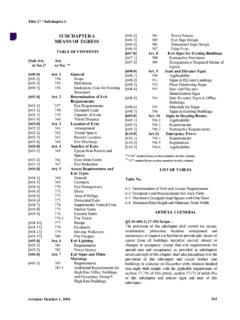Transcription of Allowable Number of Students in a Classroom - ROE 41
1 Allowable Number of Students in a Classroom Inevitably each school year the question arises whether applicable building, fire or life safety codes limit the Number of Students that can safely occupy an elementary or secondary school Classroom . The Office of the State Fire Marshal (OSFM) and the Illinois State Board of Education (ISBE) typically receive several requests for information regarding this subject and recognizes that the issue is often the source of controversy and concern to school administrators, teachers unions, parent interest groups and elected officials. As a result, this document was prepared to offer a review of the code requirements specifically pertaining to educational Classroom occupancy and egress. As is explained, the codes do not set pre- determined limits on the Number of Students that can be accommodated in a Classroom environment. Rather, the codes require that occupant loads be calculated based on the area of the Classroom and prescribed occupant load factors in order to ensure that proper Number and width of exits are provided from each Classroom .
2 The resulting occupant loads virtually never result in Classroom occupancy limitations that even approach the lower numbers being discussed as reasonable by educators, teachers or parents. In other words, the building, fire and life safety codes applicable to Illinois schools will very rarely be used as the deciding factor relative to the maximum Number of Students that will be allowed in a Classroom . Applicable Codes In accordance with Illinois statutes, public elementary and secondary schools outside of the City of Chicago are under the jurisdiction of the Illinois State Board of Education (ISBE) for building and fire code adoption and enforcement purposes. ISBE rules are found in multiple sections of the Illinois Administrative Code depending on when the school was approved for construction1. Those rules reference various editions of the International Code Council (ICC) and the BOCA (Building Officials and Code Administrators) fire and building codes to govern school construction and fire safety.
3 Also, for schools approved for construction prior to March 24, 1995 older versions of the ISBE Health/Life Safety Codes apply. These are commonly referred to as Part 185 and Part 175. (123 Ill. Adm. Code Parts 175, 180 and 185). For private elementary and secondary schools, as well as public schools within the Chicago Board of Education system, the Office of the State Fire Marshal's (OSFM) adopted Life Safety Code is applicable. The Life Safety Code is published by the National Fire Protection Association (NFPA) as NFPA 101 and the State of Illinois has currently adopted and enforces the 2000 edition of the NFPA Life Safety Code. Allowable Number of Students in a Classroom Page 1. Type of School Authority and Applicable Codes Public Elementary and Secondary Schools outside Illinois State Board of Education (ISBE) Health/Life of the City of Chicago Safety Code Depending upon the year the school was approved for construction, various parts 1 of the ISBE Health Life Safety Code that reference various editions of the International Code Council's (ICC) codes or Building Officials and Code Administrators (BOCA).
4 Codes as well as Part 185 and Part 175 apply. 1. 23 Ill. Adm. Code Parts 175, 180 and 185. Locally adopted codes are not applicable Private Elementary and Secondary Schools Office of the State Fire Marshal (OSFM). Chicago Public Schools 2000 edition of the National Fire Protection Association's Life Safety Code (NFPA 101) as adopted by the OSFM applies. Locally adopted codes and ordinances may impose more stringent requirements General Approach to Calculating Allowable occupant Load Both the OSFM-adopted NFPA Life Safety Code and the rules and codes of the ISBE Health/Life Safety Code regarding occupancy loads are provided in order to determine the largest Number of occupants for whom exit components must be provided. They are not intended to set limits on the Number of Students that can be served in an educational Classroom other than to ensure that proper Number and widths of exits are provided. None of the applicable codes contain a simple statement that is often being sought by those investigating this subject such as No more than 30 Students shall occupy a Classroom .
5 Or Maximum occupant load in any educational Classroom is limited to 25 Students . What often causes the subject to be misunderstood is that the codes do address occupant load factors . and capacity factors that at first would appear to establish the maximum Number of Students allowed in a room. However, an explanation of how these factors are meant to be applied will hopefully demonstrate that they do not establish occupant load limits. Both ISBE and OSFM codes establish an occupant load factor which is a designation of the Number of square feet per person that must be used to calculate the occupant load of a room. However, this occupant load does not represent the maximum Allowable Number of occupants that can ever occupy the room. Rather, the occupant load is simply used to determine if an adequate Number and width of means of egress ( , doors) are provided from the room to accommodate that Number of occupants.
6 The codes then allow occupant loads to be increased as wider or more means of egress are provided from the room. Allowable Number of Students in a Classroom Page 2. To phrase in a different way, by using the occupant load factors found in the codes we are actually calculating the minimum occupant load for which the means of egress for rooms, spaces and the building must be designed. The codes do not limit the occupant load density of an area, but once the occupant load is established, the means of egress must be designed for at least that capacity. If it is intended the occupant load will exceed that calculated in accordance with prescribed occupant load factors, then the means of egress design is to be based on the actual Number of people. For those that are hopeful that this calculated occupant load will result in a limitation on the Number of Students that can be allowed to occupy a Classroom , there is most often a disappointment when the calculation is actually done.
7 As you will see in the example calculation offered below, the Allowable Number of occupants in a Classroom is limited by the Number and width of the means of egress (doors). from that room. However, by simply providing one door from the Classroom at the code's minimum allowed width the occupant load of a typical Classroom virtually always far exceeds the limitations that are being sought by interested parties for educational overload issues. Typical disputes about Classroom sizes may address the 25 to 35 student range. However, the Allowable occupant load of an average size Classroom based upon the provision of one door of the minimum allowed width being provided is in the 140 occupant range! Therefore, although the size of a Classroom can affect the calculated occupant load, application of the calculation methods prescribed by the building, fire and life safety codes virtually always result in Allowable Classroom occupancy by a Number of occupants that far exceeds the numbers being debated for educational and supervision purposes.
8 Example Calculation of Allowable occupant Load in a Classroom : 2. Classroom dimensions: 25 ft. x 35 ft. Area of the Classroom : 875 ft 2. OSFM Life Safety Code occupant Load Factor for educational classrooms is: 20 net ft / occupant Note that the occupant Load Factor for classrooms within the ISBE Health/Life Safety Code ranges from 18 or 20. 2 2. ft / occupant up to 40 ft / occupant for some older schools. Also, for other school use areas different occupant load factors may be applied ( , 15 in cafeterias, 12 in study halls and 25 in libraries, etc.). This would change the below calculations accordingly for these different use areas, but not appreciably in terms of attempting to limit the total Number of occupants to that usually being sought for educational/supervision reasons. Note also the codes use either gross floor area or net floor area for calculating occupant loads: Net floor area is the floor area that is the actual occupied area, not including accessory unoccupied areas or thickness of walls.
9 Gross floor area is the floor area within the inside perimeter of the outside walls of the building under consideration with no deduction for hallways, stairs, closets, thickness of interior walls, columns, or other features . Allowable Number of Students in a Classroom Page 3. Calculated occupant load: 2 2. 875 ft divided by 20 net ft / occupant = occupants. Rounding up = 44 occupants. However, this does not equate to 44 occupants being the total that are allowed to occupy the Classroom . Rather, the 44 occupant Number is then used to determine if the means of egress (doors). from the Classroom provide sufficient egress width. The 44 occupants must be multiplied by another Number called the Capacity Factor for an educational occupancy used for doors. This will determine the Number of inches of egress width that is necessary to allow a smooth flow of occupants through that door. But we can work this same process backwards; by taking the clear width of an existing doorway and determining how many occupants that door can handle.
10 The Capacity Factor prescribed by most of the codes for a door is inches per person. Working the math in reverse , a 28 inch wide door can accommodate 28 = 140 occupants. Therefore, theoretically under most of the codes used in Illinois including most of the codes adopted by the ISBE Health/Life Safety Code, up to 140 occupants could be within the 875 sq. ft. Classroom and be able to safely egress through the one 28 inch wide doorway. It is for this reason that attempts to imply that the State's fire code or Life Safety Code limit Classroom size to only 20 Students is erroneous. The 20 sq. ft. / occupant factor (or other factors prescribed by ISBE rules) is used only to calculate necessary width of egress components and not to set an occupant limit on any room or space. As exit width is increased, or as more exits are added ( , a 2nd exit door from the Classroom ) the total occupant load of the room is allowed to be correspondingly increased.




